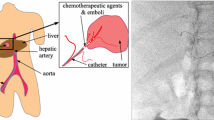Abstract
Object
Coronary artery bypass grafting (CABG) is the standard treatment for advanced coronary artery diseases. In a preoperative MSCT, both wall plaque formations and resulting optimal anastomotic site are visible to the surgeon. During surgery, the identification of this position on the surface of the heart is of utmost importance for an effective revascularisation procedure. To assist the surgeon in this matter, a surgical navigation system for the open heart is desirable. This work focusses on an appropriate method for registration of a patient-specific map of the coronaries extracted from preoperative MSCT data with optical tracking data recorded intraoperatively at the ischaemic heart.
Methods
The proposed registration process is based on mutually shared anatomical point landmarks and vessel paths on the heart surface utilised in an enhanced weighted ICP algorithm. Bypass grafting predominantly takes place at the ischaemic heart which is significantly distorted compared to its preoperative shape. To account for that, the method includes corrections for the effects of muscle relaxation and torsion of the ischaemic heart.
Results
The registration process was tested retrospectively on real patient data recorded at the ischaemic heart during bypass grafting. After registration, the vessel paths and point landmarks recorded intraoperatively by the surgeon showed good accordance with the preoperative map of the coronaries.
Conclusion
The registration method presented here is capable of matching the relevant parts of a preoperatively extracted map of the coronaries with intraoperatively recorded optical tracking data. Thus, it can be used as a basis for a surgical navigation system intended to assist the surgeon in the localisation of the optimal anastomotic site during CABG.
Similar content being viewed by others
References
Klotz S, Scheld HH (2007) Modern therapeutic strategies for coronary artery bypass grafting (CABG). Dtsch Arztebl 104(48)
Peters TM (2000) Image-guided surgery: from X-rays to virtual reality. Comput Methods Biomech Biomed Eng 4(1): 27–57
DiGioia AM, Picard F, Jaramaz B, Sell D, Moody JC, Playkseychuk A, Levison TJ, Nikou C, LaBarca RS, Muir P (2001) Computer assisted navigation systems for hip and knee reconstructive surgery, ASME 2001 design engineering technical conferences and computers and information in engineering conference
Coste-Manière È, Adhami L, Mourgues F, Bantiche O (2004) Optimal planning of robotically assisted heart surgery: first results on the transfer precision in the operating room. Int J Robot Res 23(4–5): 539–548
Alperin N, Levin DN, Pelizzari CA (1994) Retrospective registration of X-ray angiograms with MR images by using vessels as intrinsic landmarks. J Magn Resonan Imaging 4: 139–144
Mourges F, Vieville T, Falk V, Coste-Manière È (2003) Interactive guidance by image overlay in robot assisted coronary artery bypass. MICCAI 2003, LNCS 2878, pp 173–181
Mäkelä T et al (2002) A Review of Cardiac Image Registration Methods. IEEE Trans Med Imaging 21(9): 1011–1021
Hill DL et al (1991) Registration of MR and CT images for skull base surgery using point-like anatomical features. Br J Radiol 64(767): 1030–1035
Gower JC, Dijksterhuis GB (2004) Procrustes problems. Oxford University Press, NY
Besl PJ, McKay ND (1992) A method for registration of 3-D shapes. IEEE Trans Pattern Anal Mach Intell 14(2): 239–256
Zinsser T, Schmidt J, Niemann H (2003) A Refined ICP Algorithm for Robust 3-D Correspondence Estimation. Proc IEEE Int Conf Image Process 2: 695–698
Zhang Z (1994) Iterative Point Matching for Registration of Free-Form Curves and Surfaces. Int J Comput Vis 13: 119–152
Gruen A, Akca D (2005) Least squares 3D surface and curve matching. ISPRS J Photogramm Remote Sens 59(3): 151–174
Rusinkiewicz S, Levoy M (2001) Efficient variants of the ICP algorithm. Proceedings of the third international conference on 3D digital imaging and modeling, pp 145–152
Fitzpatrick JM, West JB, Maurer CR Jr (1998) Predicting error in rigid-body point-based registration. IEEE Trans Med Imaging 17(5): 694–702
Author information
Authors and Affiliations
Corresponding author
Rights and permissions
About this article
Cite this article
Gnahm, C., Hartung, C., Friedl, R. et al. Towards navigation on the heart surface during coronary arterty bypass grafting. Int J CARS 4, 105–112 (2009). https://doi.org/10.1007/s11548-008-0273-y
Received:
Accepted:
Published:
Issue Date:
DOI: https://doi.org/10.1007/s11548-008-0273-y




